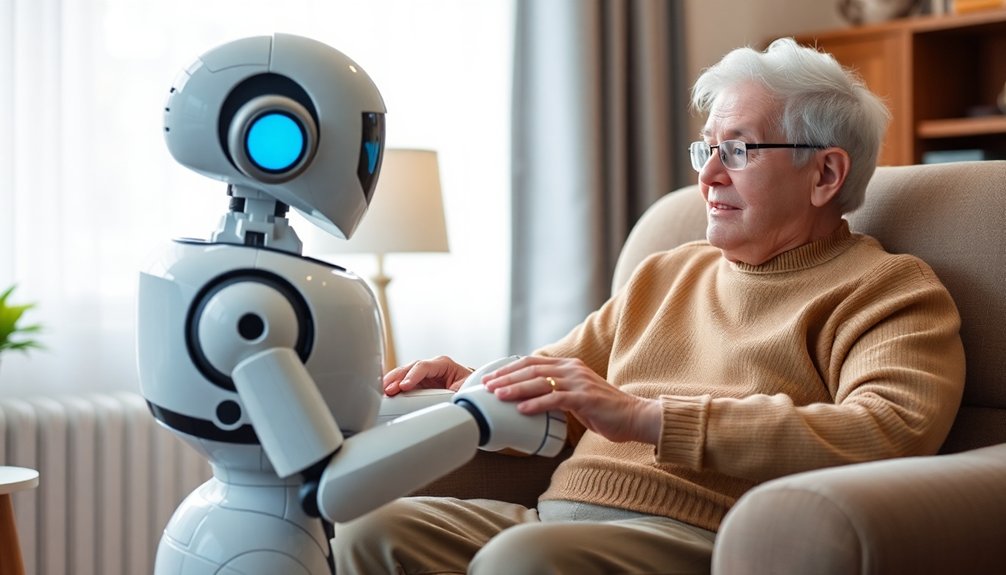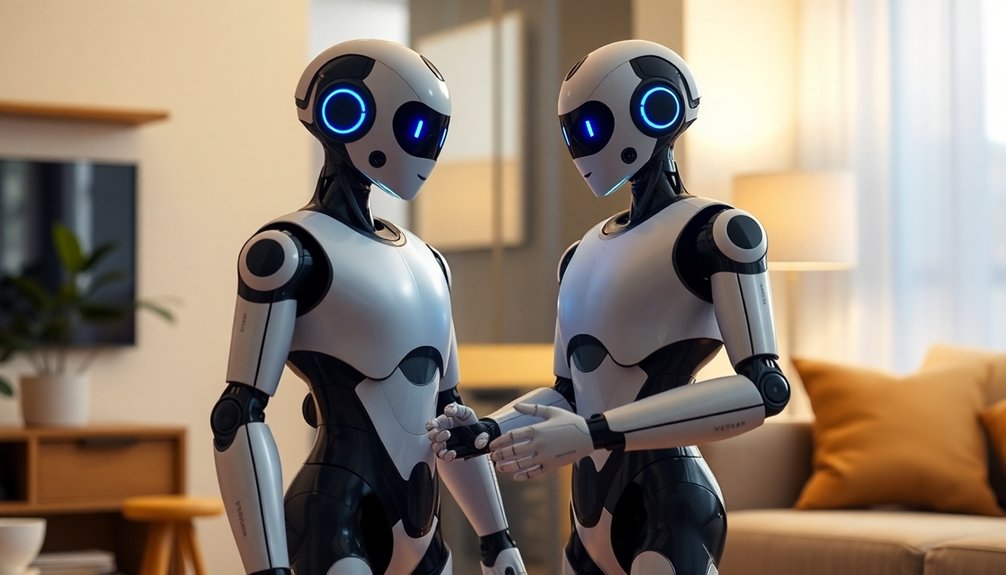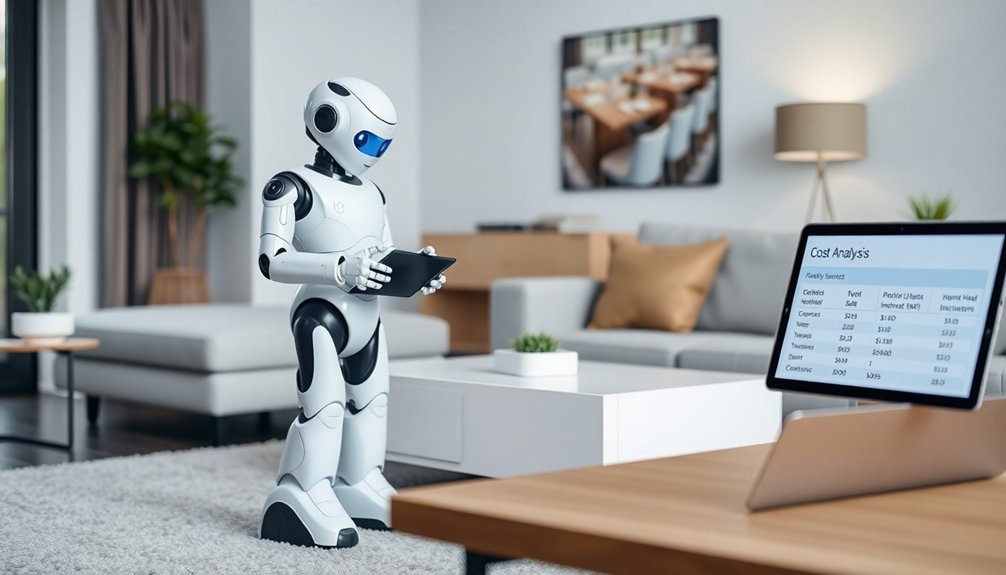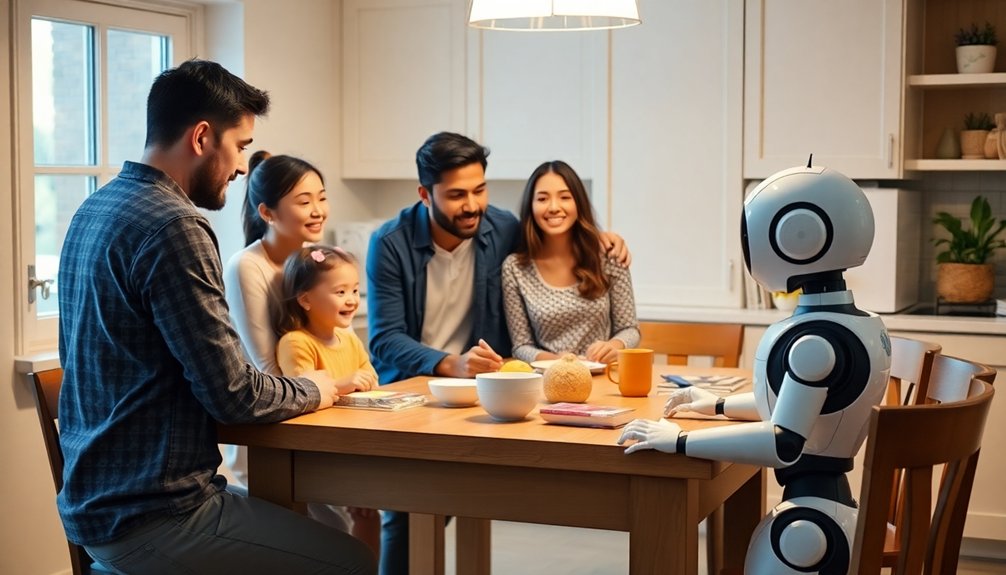Table of Contents
We’ve scoped out the coolest home robots that could totally transform your domestic life. From the Walker S1’s elder care wizardry to Sophia’s mind-blowing conversational skills, these machines are more than just fancy gadgets. They’ll fetch your meds, chat about your day, and navigate your home like tech-savvy ninjas. Want to know which robot might become your new best friend? Stick around, because the future just got weird.
Walker S1: Pioneering Elder Care Assistance

Meet Walker S1: the robotic butler your grandparents never knew they wanted. This humanoid wonder stands 1.64 meters tall, packed with 41 servo joints that make traditional walkers look like dinosaur tech. Force-compliant drive joints enable the robot to maintain incredible stability and smooth movement across different surfaces.
Its dexterous 5-finger hands aren’t just for show—they’re engineered to fetch medications, grab coffee mugs, and maybe even challenge you to a chess match. Advanced neuromorphic computing will allow the robot to learn and adapt to individual user needs more intuitively.
Walker S1’s advanced motion control means it navigates home environments like a pro, avoiding obstacles and adapting faster than your tech-challenged uncle learning a smartphone.
Robotic reflexes sharper than your uncle’s tech skills—Walker S1 glides through homes like a digital ninja.
Semantic VSLAM Navigation enables the robot to understand spatial environments with unprecedented precision, enhancing its ability to move and interact within complex home settings.
With potential elder care applications that go beyond simple assistance, this robot could revolutionize how we support aging populations.
Imagine a companion that monitors health, provides social interaction, and handles daily tasks—all while looking like something straight out of a sci-fi movie.
Sophia by Hanson Robotics: Conversational AI Companion
Meet Sophia, the chatty robot who’s basically your smartest, weirdest tech friend who never stops learning. She’s not just another fancy gadget, but a conversational AI companion who can track your movements, recognize your face, and engage in surprisingly nuanced dialogue that’ll make you wonder if we’re living in a sci-fi movie. With her ability to understand context, generate human-like responses, and adapt her interactions, Sophia represents a tantalizing glimpse into how future home companions might blur the line between machine intelligence and genuine social interaction. Supported by ROS framework, Sophia leverages advanced software architecture to enable more sophisticated and responsive interactions with humans. Her groundbreaking cognitive architecture allows her to process complex emotional and social cues, making interactions feel more natural and intuitive. Her remarkable capabilities are driven by advanced language models that enable her to interpret complex human instructions with unprecedented precision and contextual understanding.
Conversational AI Prowess
While humanoid robots might sound like sci-fi fantasy, Sophia by Hanson Robotics represents a quantum leap in conversational AI that’s already changing how we think about machine intelligence. Her capabilities showcase remarkable advancements in understanding human emotions and interaction dynamics. Saudi Arabia’s recognition of Sophia as an honorary citizen underscores her groundbreaking technological significance. Ethical AI development continues to challenge researchers in creating robots that balance technological potential with moral considerations. Neuromorphic computing enables Sophia to process complex emotional interactions beyond traditional programmed responses.
Imagine a robot that doesn’t just respond, but actually seems to understand you. Sophia isn’t just repeating programmed lines—she’s synthesizing conversation, reading subtle social cues, and engaging with an intelligence that feels remarkably close to human interaction.
She’s not perfect, but she’s a tantalizing preview of our AI-powered future.
What makes Sophia extraordinary? Consider these killer features:
- Real-time speech recognition that catches nuanced communication
- Dynamic emotion simulation mimicking human-like responses
- Facial recognition tracking conversational context
- Neural network processing for adaptive learning
- Multilingual communication capabilities
Social Interaction Skills
Stepping beyond mere conversational capabilities, Sophia’s social interaction skills reveal a robot that’s less silicon-and-circuits and more potential companion. Robotic neural networks enable her to generate movements that enhance her expressiveness and make interactions more dynamic.
Her emotion recognition isn’t just cool tech—it’s borderline magical. She reads human feelings like a savvy therapist, adapting conversations with an intelligence that’s both impressive and slightly unnerving. Multimodal emotional intelligence allows her to integrate text, voice, and visual cues for a comprehensive understanding of human emotions.
As a cultural ambassadorship pioneer, Sophia isn’t just another robotic novelty. Emotional AI integration demonstrates her capacity to bridge technological innovation with human-like social understanding, creating a profound connection between human and machine.
She challenges how we think about machines, blurring lines between artificial and authentic interaction. Her ability to simulate emotions and display human-like expressions makes her more than a gadget—she’s a conversation starter about our technological future.
Can a robot genuinely understand us? With Sophia, we’re getting uncomfortably close to saying “maybe.”
Educational Engagement Potential
Anyone wondering how robots might transform education should meet Sophia, the AI companion that’s rewriting the rulebook on learning technology. Advanced AI Research reveals that Hanson Robotics’ innovative approach creates meaningful interactions between technology and learners. Realistic Facial Expressions enable Sophia to communicate with remarkable human-like nuance, enhancing educational engagement. Neuromorphic computing allows Sophia to develop increasingly sophisticated emotional intelligence during interactions.
We’re witnessing a revolution in STEM education that turns traditional learning on its head:
- Sophia breaks down complex AI concepts into digestible, engaging interactions
- Little Sophia empowers girls to explore coding and robotics
- Interactive experiences spark critical thinking about technology’s societal impact
- Hands-on learning transforms abstract concepts into tangible skills
- Robotics becomes less intimidating, more approachable for curious minds
Samsung’s Ballie: Smart Home Monitoring and Entertainment
We’ve all dreamed of a robot sidekick that could keep an eye on our home and maybe even play with our pets, and Samsung’s Ballie might just be that futuristic companion we’ve been waiting for.
Imagine a yellow ball-shaped robot that can roll around your house, checking on your cat, projecting entertainment, and managing your smart home devices like some kind of adorable technological wizard.
It’s part security system, part entertainment center, and part digital buddy – basically the Swiss Army knife of home robotics that’ll make you wonder how you ever lived without a spherical AI assistant rolling around your living room.
Smart Home Integration
When Samsung revealed Ballie, their spherical robot sidekick, they basically reimagined what “smart home” could actually mean. This little orb isn’t just another gadget—it’s a game-changer in home automation that transforms how we interact with technology.
Ballie’s smart home prowess includes:
- Seamless smart device compatibility across multiple platforms
- Creating personalized automation routines that adapt to your lifestyle
- Autonomously traversing rooms while managing connected systems
- Providing real-time monitoring through integrated cameras
- Learning and anticipating user preferences without constant programming
Imagine a robot that understands your home’s rhythm better than you do—moving between rooms, adjusting thermostats, checking security, and projecting entertainment, all while staying one step ahead of your needs.
It’s less like a device and more like a hyperintelligent roommate who actually pulls its weight.
Pet Companion Features
The spherical robot that wants to be your pet’s new best friend might sound like sci-fi, but Samsung’s Ballie is making it a reality. This little orb doesn’t just sit around; it actively monitors pet health through continuous surveillance and interactive entertainment. With AI-powered insights, Ballie learns your furry friend’s habits and sends video updates when you’re away.
| Feature | Benefit | Impact |
|---|---|---|
| Autonomous Navigation | Constant Pet Monitoring | Peace of Mind |
| Projector Functionality | Interactive Pet Entertainment | Mental Stimulation |
| Multimodal AI | Personalized Care | Enhanced Interaction |
Want a robot that understands your pet better than you do? Ballie tracks movement, projects engaging content, and transforms your smart home into a pet paradise. It’s like having a digital pet nanny that never sleeps, never complains, and always keeps an eye on your four-legged companion.
Top Features to Consider in Home Humanoid Robots

How do you invite a silicon-and-servo buddy into your home without turning your living room into a sci-fi disaster zone?
When considering a home humanoid robot, sensor integration is your first line of defense. We’ve learned that top-tier robots come packed with safety features that make cohabitation less terrifying:
- Advanced vision systems that practically see through walls
- Tactile sensors ensuring they won’t crush your favorite houseplant
- Emergency stop mechanisms faster than your reflexes
- Lightweight designs that won’t demolish your furniture
- Collision avoidance smarter than most drivers
Imagine a robot that understands context, adapts to your lifestyle, and moves with human-like grace.
A silicon soul synchronized to your world: intelligent, intuitive, and moving with elegant precision.
These aren’t sci-fi fantasies—they’re today’s reality. Your future home companion isn’t just a machine; it’s an intelligent, responsive helper designed to integrate seamlessly into your daily routine.
Performance Comparison: Robot Capabilities and Limitations
Let’s face it: humanoid robots aren’t just fancy toys anymore, they’re potential household teammates with real-world performance that’ll make your smart speaker look like a paperweight.
These mechanical marvels pack serious task flexibility, maneuvering home environments with sensors that’d make a bat jealous. Performance metrics reveal impressive capabilities: they understand natural language, recognize objects, and manipulate items with precision that’s almost human-like.
But they’re not perfect. Battery limitations mean periodic recharging, and complex tasks can still throw them for a loop. Their adaptability is improving, though, with AI learning your household quirks faster than a new roommate.
Are they ready to completely replace human help? Not quite. But they’re getting closer, one dexterous movement at a time.
Cost Analysis: Investment vs. Practical Home Usage

After witnessing robots dance through home environments with near-human precision, we’ve got to talk money. Cost justification isn’t just about sticker shock—it’s strategic budget planning.
Here’s the real scoop on humanoid robot investments:
- Home-use robots range from $5,000 to $20,000, with operational costs potentially lower than human workers
- Long-term savings can offset initial high investment
- Basic task robots (cleaning, monitoring) are more wallet-friendly
- Advanced customization dramatically increases price tags
- Industrial-grade models can hit a whopping $150,000
Sure, dropping five figures on a robot might sound crazy.
But when you calculate efficiency gains, reduced labor costs, and the pure sci-fi coolness factor, suddenly those zeros start looking like a smart play.
Who wouldn’t want a mechanical buddy handling life’s most mundane tasks?
Future Trends in Domestic Robotics Technology
Wondering what domestic robots will look like in the next decade? We’re betting on some wild transformations. Home automation is about to get seriously smart, with robots that learn autonomously and adapt faster than your smartphone updates.
| Trend | Impact | Coolness Factor |
|---|---|---|
| Soft Robotics | Enhanced Safety | High |
| AI Learning | Personalized Assistance | Extreme |
| Green Tech | Eco-Friendly Design | Moderate |
| Healthcare Support | Aging Population Help | Significant |
| Modular Design | Customizable Functions | Impressive |
The future isn’t just about having a robot—it’s about having a robotic teammate that understands your life’s rhythm. We’re talking machines that can switch tasks faster than you change channels, learn your quirks, and potentially save you hours of mundane work. Imagine a helper that’s part appliance, part companion, and completely game-changing. Sounds like sci-fi? Not anymore.
Ethical Considerations of AI-Powered Home Robots

While robots might sound like the next cool gadget, they’re entering our homes with more baggage than just circuit boards and algorithms. The ethical landscape of AI-powered home robots is complex and riddled with potential landmines.
We need to be vigilant about:
- Privacy implications that could turn our living spaces into surveillance zones
- Potential bias in AI systems that might discriminate subtly
- Balancing technological convenience with human autonomy
- Ensuring transparent decision-making processes
- Protecting vulnerable populations from technological exploitation
Bias mitigation isn’t just a technical challenge—it’s a human responsibility. As these robots become more integrated into our daily lives, we can’t ignore the deeper questions about control, ethics, and the boundaries between helpful technology and intrusive intelligence.
Who really owns the data? Who decides what these robots learn?
User Experience and Real-World Deployment Insights
The uncanny valley just got a makeover—and it’s wearing a soft nylon exterior.
We’re witnessing humanoid robots transform from sci-fi fantasies into practical home helpers.
Our user experience reveals robots like Neo Gamma aren’t just cool tech—they’re becoming functional companions that vacuum, fold laundry, and provide medical support.
Deployment insights show these machines aren’t perfect, but they’re rapidly improving.
Imagine a robot that learns your preferences, adapts to your home’s layout, and handles mundane chores while looking like a sleek, minimalist design piece.
They’re not replacing humans, but complementing our lives with smart, autonomous capabilities.
Cost remains a hurdle, but as technology advances, these silicon-and-nylon helpers will become more accessible.
The future isn’t distant—it’s already unpacking your groceries.
People Also Ask
Can Home Humanoid Robots Replace Human Caregivers Entirely?
We can’t fully replace human caregivers due to caregiver limitations, but robots offer advantages like continuous monitoring and task assistance that complement human care effectively.
How Secure Are Home Robots Against Potential Hacking Risks?
We’re cautious about home robot security, implementing robust data encryption and strict security protocols to mitigate potential hacking risks and protect personal information from unauthorized access.
What Maintenance Costs Are Associated With Home Humanoid Robots?
Like a car needing tune-ups, home humanoid robots demand ongoing maintenance. We’ll face repair costs ranging from $500–$2,500 annually, plus essential software updates that keep our robotic companions functioning smoothly.
Are Home Humanoid Robots Compatible With Different Home Environments?
We’re finding home humanoid robots can adapt to different environments through advanced environmental sensors, enabling interior adaptability across varied household layouts, though customization and extensive AI training remain critical for seamless integration.
Do Home Robots Learn and Improve Their Skills Over Time?
We’ve discovered that home robots learn and improve through machine learning, continuously enhancing their skills by adapting to our environments, predicting tasks, and refining behaviors based on user interactions.
The Bottom Line
We’ve explored the wild world of home robots, and let’s be real: they’re cooler than we ever imagined. Remember that first iPhone? These robots are our generation’s tech revolution. Some will change lives, some will collect dust—but all represent humanity’s endless curiosity. As prices drop and capabilities expand, home robots won’t just be gadgets; they’ll be teammates, caregivers, and unexpected companions. The future isn’t coming. It’s here, and it’s wearing a circuit board.
References
- https://www.ericjkuhns.com/blog/best-tech-i-saw-from-ces-2025-robots-ai-and-more
- https://standardbots.com/blog/most-advanced-robot
- https://qviro.com/product-category/humanoid-robot
- https://www.ubtrobot.com/en/humanoid/products/WalkerS1
- https://qviro.com/product/ubtech-robotics/walker-s1/specifications
- https://www.ubtrobot.com/en/humanoid/products/WalkerS
- https://humanoid.guide/product/walker-s1/
- https://aicyberinfo.com.au/products/ubtech-humanoid-robot-walker-s1
- https://www.hansonrobotics.com/sophia-2020/
- https://www.hansonrobotics.com/sophia/